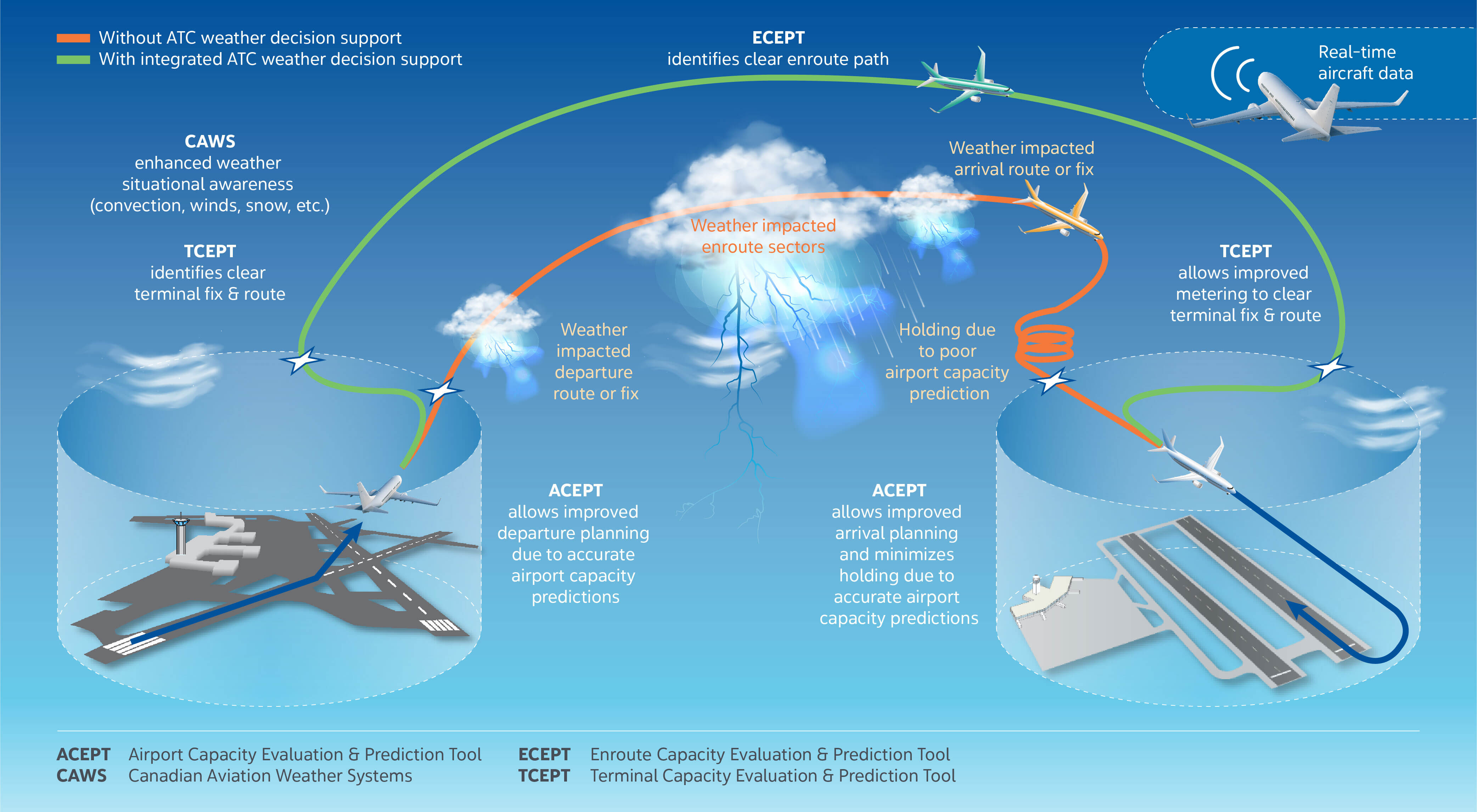







July 21, 2022
NAV CANADA is partnering with the Massachusetts Institute of Technology (MIT) Lincoln Laboratory to develop state-of-the-art technologies for managing capacity and demand imbalances for airports, terminals, and enroute airspace under challenging weather conditions. These technologies will result in the ability to make more objective and accurate predictions of strategic and tactical airspace impacts, and then to make more informed traffic management decisions with more lead time than ever before.
The solutions being developed are also a building block for Trajectory-Based Operations (TBO), a strategic priority for NAV CANADA that represents a significant advancement over current capabilities. With TBO, rather than managing aircraft trajectories separately within each “Flight Information Region,” they will be managed across the entire flight, from departure to destination. To be able to view each flight in its totality, a complex amalgamation of weather, airport capacity, and demand data will be analysed up to twelve hours in advance. (Weather has always been a major challenge for effective TBO implementation.) The result will be safer, more predictable, more efficient air travel.
.jpg)
“This project originally grew out of our work on enhancing flow management,” explains Bill Crawley, Director, Business Architecture at NAV CANADA. Flow management is the process of managing airline traffic to address capacity/demand imbalances across the system to ensure smooth, safe, and efficient flight experiences. “We wanted to find a solution that would push the envelope. So, we sought out a partner that had a track record of innovation in aviation weather prediction, which is foundational to flow management. Lincoln Laboratory was an ideal fit. They’re a real leader when it comes to weather.”
MIT Lincoln Laboratory is a U.S. federally funded research and development center that has a 50-year history of delivering innovative solutions in the design, development, and successful prototyping of aviation weather and decision support technologies. This includes technologies such as the Corridor Integrated Weather System (CIWS), a zero- to two-hour weather forecast product supporting tactical decisions, operational in many major US air traffic control facilities.
The collaboration effort fits both ways. According to Dr. Tom Reynolds, leader of MIT Lincoln Laboratory’s Air Traffic Control Systems Group, “We are very excited about working with NAV CANADA to enhance weather decision support technologies and to help enable more efficient TBO activities. NAV CANADA is an organization that is at the forefront of embracing innovation in airline safety, weather impact mitigation, and air traffic management. It oversees a vast airspace that has some of the most dynamic and challenging weather in the world. This collaboration leverages the strengths of both partners, so we really look forward to developing impactful technologies for users.”
.jpg)
NAV CANADA’s team visits MIT Lincoln Laboratory in April 2022. Bill Crawley is centre front row. Tom Reynolds is back row, third from the right.
The first phase of the project will entail bringing together various weather models to gain a completer and more accurate picture of weather impacts. The solutions will apply sophisticated algorithms to the data that generates these pictures to predict capacities at various key points in the aviation system. They will then compare those capacities to traffic demand expected at those same points up to 12 hours into the future. This information will result in the ability to make objective recommendations on potential best courses of planning actions. All of this will be shared in real time among stakeholders, including Operations, Traffic Management Unit, Airlines, and Airport Authorities, who will then work together to make final decisions to minimize imbalances in capacity and demand.
The project will ultimately produce the following set of integrated technologies for managing demand and capacity imbalances at airports and in terminal and enroute airspace:

The first phase of activities includes the development of the new ACEPT and TCEPT technologies. These are targeted for initial prototype deployment at Toronto Pearson International Airport over the next two years. The other technologies will roll out in phases over the next five years. Ultimately, all the solutions will be transitioned to NAV CANADA for operation and integration into their existing Air Traffic Management automation systems.
Accurate, objective weather analysis and prediction lies at the heart of these developments and of effective TBO implementation under all weather conditions. Expanding weather prediction capabilities is also of increasing importance to the safety and efficiency of air travel as major weather events become more severe and frequent. For these reasons, NAV CANADA is partnering with the best expertise in the world to become a leader in aviation weather decision support technologies. This will be key to NAV CANADA remaining one of the safest and most efficient air navigation service providers in the world, long into the future.